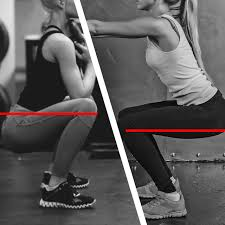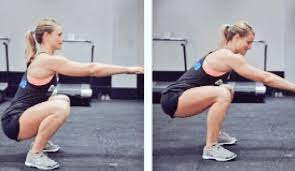This is, for some, still a very hot topic that is argued over in the Physio/AT/S&C/Sports Coach/Former Athlete circle for what I can see is going on since and for FOREVER!!
Even the average person on the street who went to the gym once, seems to have their reason for why you should or shouldn’t squat deep. Due to the arguments I feel that there are people being caught in the middle. People perhaps who for some reason, shouldn’t squat deeper – Leading to injuries. Others who can squat deeper, but have not been loaded into that position and are either missing out on performance, or causing injuries in a different way.
This blog, ideally, is to help shed some light on the subject. To give an understanding on why you may or may not choose to deepen a squat. Firstly lets just ease ourselves into it. We break it down to some common complaints people may have with squatting.
“But, I’ve heard that squatting past 90 degrees is bad for your knees, right?”

Unfortunately we hear this a fair bit in clinic, and in the gym. I used to think “if I hear this once more from a person I’m going to scream”. Then I realised they’re the ones getting caught in the middle. It should be the likes of us being screamed at for this, not the person who comes in, with pain or injury. . . Apologies, rant over. The fact is, for most the idea of squatting below 90 being bad for your knees is a myth. Take the ACL, forces on that peak in the partial squat depths, and then reduce as squat depth deepens and compressive forces increase, reducing ACL shear forces.
“But, but my Cartilage?. If that gets damaged I’m goosed”
Ok, this one has some merit to it. Damaged cartilage is not ideal. Can lead to pain and problems.
Yes, compressive forces on the meniscus (cartilage) increase as squat depth deepens. However, if you have no injury to this area, there is not much evidence to suggest deep squats cause injury or increase risk of injury to these areas.
That being said, IF you do have a torn meniscus or even anterior knee pain in general, it is generally a smart idea to limit your squat depth – initially at least. If you’ve had these problems years ago, and are not in pain any more, my advice here is to listen closely to your body. (Example – You may be fine to squat to a deeper level with body weight, but not with added weight).
Aim to increase the squat depth unless it causes pain, in which case you can reduce the depth. You will know your body better than anyone else.
“My Patellar Tendon is giving me pain, can I squat at all?!

So, like above as the squat depth increases, the compressive load on the patellar tendon also increases. This can definitely aggravate the tendon, making it sore and tender. Definitely here my advice here is to modify your squat depth – again in the initial stages where it is very irritable. However tendons like to be loaded, but loaded in the correct manner. If you go too hard, too fast, it can lead to problems. Much like too deep, too soon can lead to problems.
While rehabbing an injury like this, things like Reverse Lunges, Low Bar Back Squats, Box Squats will all have similar benefits to the High Bar Back Squat, but with way less anterior knee stress. Again, listening to your body closely will help here. The reason your tendon may have been injured initially could be due to poor form, or lack of tendon tensile strength. So over time, you MAY be able to squat deeper.
“Aghhh no, I get a pinch in my hip doing deep squats”
Perhaps you feel a pinching feeling when you’re at the bottom of your squat? In this case, it is often caused by an impingement of two bony surfaces in the hip. Naturally, this impingement often becomes worse deeper into a squat as the bones are pushed more together.
IF this is you, it again may be wise to bring the depth up to a pain free range, until you have resolved the issue. If it is from a genuine hip impingement, these are caused by structural abnormalities and differences in the hip joint. Unfortunately little can be done here, we can’t change the hardware.
These “hardware” issues may indeed be from birth, and aren’t causing issues, doing any damage once you remain in a depth that is comfortable. That said, you may find that widening your stance, turning your feet outwards slightly, can often greatly help this. It takes the bony pinching away and still allows depth.
Play around with the foot and width position and see how it feels. Glute activation techniques may help here too. They help “pull” the hip joint into a more efficient position and could alleviate some pinching.
“Last time I did a squat session my lower back was in bits for days after”
Again, something we see regularly in clinic.
You may have racked up the bar, felt an ache during it, or even felt pain for hours/days afterwards. You potentially may have squatted too deep and irritated some disc issues (no I did not say you’ve popped a disc!!)
When you reach the bottom of your hip flexion range – where the laws of physics apply and there simply is no more movement going to come from your hips – your pelvic girdle will tilt posteriorly and you will create what is known as a “buttwink”. I know, it sounds hilarious, but what it suggests is lumbar spine flexion / Lower back rounding.
If there is too much rounding, and too much load, it will put pressure on the discs and pain/problems may follow. Looking at your ankle mobility may help in this case, especially your ankle range into dorsiflexion.
“Wow wait, hang on!! Are you saying my ankle affects my hips and pelvis?”

In a word, YES. But let me explain, before you call me a wizard. If your ankle has come to the end of its range of motion in a squat, your body will try to find movement from surrounding joints to achieve its desired depth.
So – ankle runs out of range – Hip needs to find more range – Hips run out of range – Pelvic girdle ends up tilting to try to create more hip flexion – Leads to rounding of your back – Potential problems with excess loading. A simple way to check your ankle mobility is known as a Knee To Wall test. Less than 10cm would be deemed as “stiff” and may need mobility work.
To sum up:
- Squat depth is HUGELY INDIVIDUAL
- Do not apply a BLANKET APPROACH TO EVERYONE.
- A depth for one person, may not be suitable for another. And there are a host of reasons why.
- If you are injury free, squat to a depth where you can at the very least control and maintain a neutral pelvis and little buttwink.
- If the buttwink kicks in before your thighs are parallel with the floor, work on hip and ankle mobility, as there are some benefits of deeper squats than partial.

Kids have great squat depth – unless there is some congenital issue. If not, movement like this should be encouraged throughout the ageing process.
Hopefully this helps you with pointers on this whole argument.
Feel free to reach out for advice.